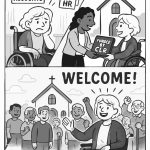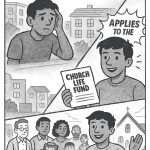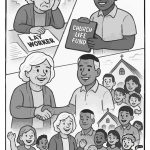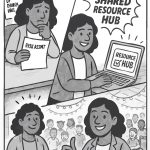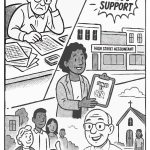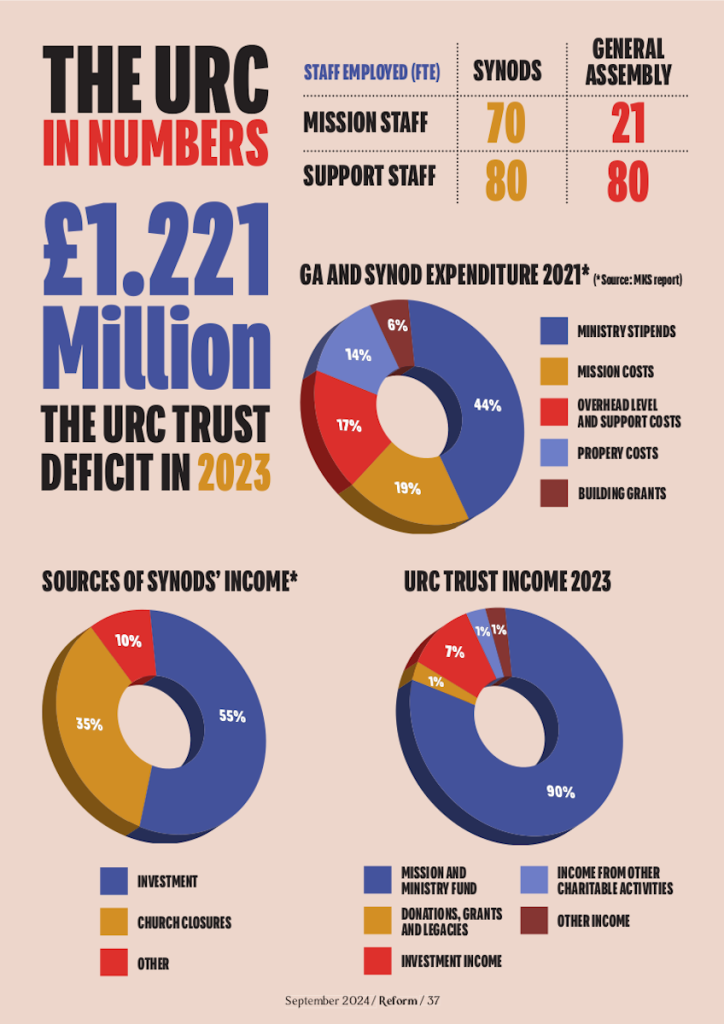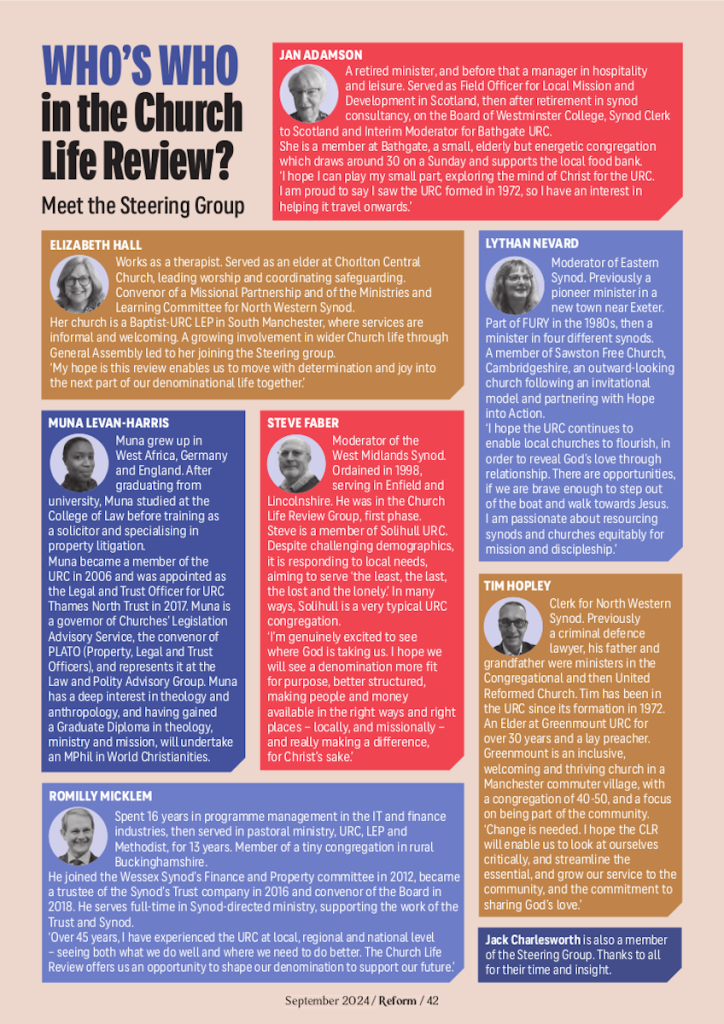Church Life Review
Here you can find out about the Church Life Review; when and why it was set up, what it aims to achieve, and the latest news, papers and webinars.
The Church Life Review was set up in 2020 to review the life, structures, resources and work of the URC to enable a faithful response to the challenges presented in Paper A1 Toward the Future of the URC. This paper reflected that the pandemic has become a moment that has revealed strengths, weaknesses and possibilities in the life of the church we maybe were not aware of.
The CLR is now in its second phase, and is being guided by a Steering Group and overseen by a Sub-Committee of the Business Committee. CLR phase two started at General Assembly in 2023, and was asked to explore new ways of working across four workstreams:
- Provision of shared support services
- Employment of lay workers in local church roles
- Financial resource sharing
- Establishment of new URC communities of worship and discipleship.
The objective of phase two is to undertake a range of investigations and deliver a set of proposals to General Assembly in November 2025.
The Steering Group are responsible for:
- Identifying/designing options for future ways of operating
- Exploring the feasibility for possible models and establishing ‘living labs’ to trial models on the ground
- Testing models against the values and principles agreed by General Assembly
- Consulting widely upon potential changes
- Producing proposals for General Assembly in 2025.
Vision, Mission and Strategy Statement
The Church Life Review Group’s vision is to have a:
flourishing Church, less burdened and better enabled
Read the full CLR Vision and Mission Statement (PDF | 265kb)
Extraordinary General Assembly – November 2025
Church Life Review Papers – Executive Summary (PDF | 131kb)
The CLR group have developed some visual resources to explain the role it is playing in reshaping the structures of the URC. Download the images on a slide with suggested wording, or view and download each image below:
- CLR visual resources (PPT | 3mb)
Church Life Review update
Read the GA2025 Church Life Review progress update below, or catch up on the presentation and Q&A session from General Assembly 2025.
- Church Life Review progress update – from GA2025 (PDF | 89kb)
The following is taken from the September issue of Reform and maps the progress so far of the Church Life Review.
The story so far
As the URC embarks on the second phase of its Church Life Review, John Bradbury, the General Secretary recaps. Newcomers start here…
The story of the Church Life Review begins with our decision to accept, name and understand the hard reality that faces us, and find ways to respond. This takes a long time, in a Church whose life flows through many interconnecting councils.
The challenges when I first became General Secretary were pretty clear. There are fewer and fewer people to take on the responsibilities of local church life. There is frustration in churches that want to do things, but haven’t got the human resources. Elders and ministers are stretched thinly and a lot of their time is taken up with things that don’t feel like the reason we want to be church. The consequence is decline in many, but not all, congregations. Churches are closing at a rate of knots. In places where we've had a witness for hundreds of years, that witness isn’t there any more. It’s disheartening.
Then there’s the work that enables the national Church to function: the training of ministers, finance, communication; we have a kind of HR department for ministers; the Joint Public Issues Team gives us a witness in the public square that no local church could have on its own; our world Church work, and our anti-racist work, would be very hard to do as individual churches. All of that is funded from the Ministry and Mission budget that local churches contribute to – the fund that pays for our ministers as well as all this work. With fewer churches and fewer members contributing, that budget gets squeezed, which means fewer ministers, and less of the work that we want to do together.
Also our Church consists of 13 synods, which have grown enormously to become one of the main ways we support local churches practically. An unintended consequence of that is that we’ve tended to reinvent the wheel 13 times and there’s quite a lot of duplicated effort.
So some things were clear from the start: we need to find ways to offer more support to local churches; we need more efficient structures; we need to reduce some of our outgoings; we need to invest resources in areas of work that thrive and grow.
Phase One of the Church Life Review included an investigation into what exactly the situation in the United Reformed Church is.
Firstly, we engaged the thinktank Theos to explore the life of the URC, what our vocation is. A picture emerged of a Church with a passion for transformative work in local communities, where our churches are often very small but have a disproportionate impact, but where people are tired. The report challenged us to think about our evangelism and how we connect the work we do with being a disciple of Jesus.
Secondly, we undertook forensic accounting, to give us for the first time a picture of where our money is and what we spend it on. This indicates areas where we might gain from fuller cooperation. It also shows that the overall wealth of the URC is always increasing. That’s a very complicated picture, with lots of caveats, but you do see that as we sell church buildings, financial reserves in synods rise, to levels that people might find quite startling.
Synods have almost no income except from investments and the sale of churches. That is a major source of income for the work of URC. So we are, as it were, selling the family silver.
And yet, we are not spending down the silver as fast as it’s coming in, and even allowing for inflation, it would appear we are potentially accruing assets. This suggests that, instead of trying to maintain the level of our assets, we might spend them to invest in the life of the Church. There will be many more church closures, unfortunately, but if we can invest some of that money in new ways of working together, in support for congregations, in developing new congregations, then perhaps our resources can begin to meet our needs.
Thirdly, we tried to streamline our central operations. We merged a lot of committees into one Resources Committee. There are continued conversations about how that works in the discipleship department. We’re aiming for a committee structure that gives us what we need using fewer people. The more siloed it becomes, the less effective it is, but when committees have a broad view of the needs of the Church, we're able to respond more effectively.
Thanks to stage one of the Church Life Review, for the first time we’ve got some clear accounts of all of this that enable us to begin to work from a common place. That enabled us at the General Assembly in 2023, with a remarkable degree of unanimity, to set off the key bits of work for stage two, which is trying to work out how we unravel this and put it back together in new ways.
How we thrive: A podcast from 2030
If the URC’s Church Life Review succeeds, things will be different six years from now. John Bradbury looks forward.
A well-known podcaster has decided to put out an episode on the strange rebirth of life in the United Reformed Church in the last few years. So they visit a few URC worshipping communities…
Village URC
Village United Refomed Church sits on the edge of the village of Village. It has always been a chapel community, and is very much not the Church, which is a large building off the village square. Ecumenical relationships are ‘OK’, but that is all. As the podcaster arrives, the Regional Buildings Officer is just leaving, having signed off the installation of an accessible entry, and renewed accessible toilets. ‘We had some money in the bank,’ says Joan, the Church Secretary, ‘but knowing where to begin sorting out the building was beyond us.’ The Regional Buildings Officer planned, commissioned and oversaw the work, consulting the congregation along the way, but doing the hard work of realising the project.
‘A few years ago we thought we’d have to close,’ Joan said. ‘Our treasurer passed away, and there was no one to take their place. Fortunately, the Synod Moderator introduced us to a new scheme where we only needed to deal with any local cash, and immediate local expenses. And most of that is electronic these days. We didn’t need to do bookkeeping or budgeting. One member who is better at computers than some of us put in a few details each week from our end, and went to the bank. We received quarterly reports, and once a year someone comes out to talk us through our financial situation. It’s been a lifeline.
‘The Regional Compliance Assistant has been a godsend too. She comes once a year and goes through our insurance policies with me, and risk assessments, and health and safety stuff and so on. It helps me know we’ve got this stuff right, and makes it much less stressful. Because we’ve got all our compliance ducks lined up, we know the wider URC will back us if anything goes wrong.’
Joan continues, ‘Because we’re not so bogged down with the building and money and so on, we’ve had time to start a coffee and chat group for older people who’ve been bereaved. I had the energy to make tea and provide some decent cake. Another member (there were only six of us) who’s not so mobile now felt able to sit and listen. Someone from one of the Resource Centres for Learning shared some useful knowledge about bereavement, and our minister (who we share with six other churches) led Bible studies on Christian hope and other topics.
‘We were tentative at first, but soon realised the main thing was to listen. A few people have come to worship on a Sunday because they felt drawn into the community. Two people decided to come into membership recently – so we’re eight now. Another asked if we’d host their grandchild’s baptism.
‘We’re still small, and it feels fragile, but we’ve got the support we need, and we are beginning to grow a bit. It’s made us feel that God has not finished with us yet, and we can make a difference.’
Community of Mary and Martha
Our podcaster arrives in a 1970s estate that feels rather unloved. Most of the shops are boarded up or have been converted into flats that the occupants hate. One shop unit was taken over three years ago by the synod, and eight people gather on a Tuesday morning. A couple have just dropped the kids at school and called in at the food bank, and people are relaxing with tea and biscuits before the midweek prayer begins.
Mary, the Pioneer Minister, begins to tell a bit of her story: ‘The synod wanted to see whether there was space for a new worshipping community to emerge in an area of deprivation where there was no church. They checked with ecumenical colleagues that no one else had a plan for the estate. The parish church is the other side of the dual carriageway, and the vicar had been concerned for some time that their work in this part of the parish was limited. With encouragement from the Archdeacon, they’ve supported our work and at times pop in.
‘A house was found for me in the estate, and I confess I was nervous to begin with. There was no real plan, I just walked the streets, listening and observing. Leaving the house on day one took a lot of effort. I found there are few places left where people can gather. The pub and post office have closed. I found my place by volunteering at the food bank, which operates out of a school. In time the school connected with me too, and I formed relationships with some of the children through assemblies and listening to reading.
‘People really welcome the chance to talk’ continues Mary. ‘There was no hurry, I was not taking decisions about them, or trying to sell them something. People shared their stories. Some wanted to talk about faith things. Did I really believe in God? Why do bad things happen to good people? What happens to me when I die? Does prayer really work? Who was Jesus?’ Amber, sitting at a table with a coffee carries on. ‘Mary’s one of the only people around here who you just instinctively feel comfortable with. When Mum died, she helped me work out what I wanted for the funeral, and was there for me. My gran always went to church and talked about saying her prayers. It was never really my thing, but I did wonder – it felt like there had to be more to life. Occasionally I’d say some kind of prayer – not that I really knew why or what I was doing.
‘Mary helped me see that you can’t really get praying wrong’ – says Amber, ‘and you just have to pray it like you feel it. She invited me to prayer time one week. I wasn’t sure, but a few weeks later I did, and I felt like I connected with the memory of Mum. I’ve been coming back since then – I love the fact that we can just talk about stuff. Mary always manages to find some story in the Bible that just kind of fits what we’re feeling that day. Then we light candles for the things that are worrying us that day. It’s definitely become an important place for me.’
Jim, the part-time administrator, comes to see if anyone wants a topup before joining them for prayer time. ‘I make sure that the shop has got what we need,’ he says. ‘I did my food hygiene certificate, so we’d be OK with that kind of thing, and I sort the money out. It means Mary doesn’t have to worry about these things. I’m the Martha to her Mary. If the synod hadn’t grasped the idea when someone first had it, and if the money hadn’t been there, we’d never have made this amazing little community happen. Someone in the synod told me that the way the money used to be done meant the synod would never have felt it could afford it – but I’m glad they decided the money was there and took the risk.’
St Mark’s Under the Bridge
Our podcaster heads south, to a relatively well-off market town. A few years ago St Mark’s had 60 people in worship on a Sunday, and 100 in membership. It was one of the largest churches in the synod, but people were not as young as they used to be, and finding elders could be hard.There was a couple of families, and some Sundays there might be four or five children in church, but other weeks none.
It is Sunday morning, and our podcaster arrives to find the church buzzing. Welcomers on the door introduce him to a small group of people enjoying a bacon roll and good coffee. ‘We realised it made sense to do refreshments before worship,’ says one of them, an elder. ‘If someone new comes, we can say hello properly before we go into worship. It was a controversial decision, but we were persuaded, for a trial period, to bring worship forward to 9.30, with breakfast from 8.30. It’s amazing how popular it was with people who hadn’t come so often. I’m not sure when the trial period is supposed to be up – probably ages ago’.
The synod had taken a very brave decision, provoking heated debate in the Pastoral Committee: it gave the church a minister on its own, meaning that in other places ministry was spread more thinly. A new scheme allowed the synod to employ the lay workers to take care of payrolls, HR policies, line management and the like. As a result, the congregation decided to use some of its reserves to employ a full-time local community worker, and a full-time youth and children’s minister. A grant allowed them to employ an administrator for jobs it was hard to find volunteers for any more.
The treasurer recalls, ‘Over time, with the odd legacy here and there, then two congregations coming together and selling a building, we ended up with a lot of money in the bank. We’d always thought it was for a rainy day – it took us a while to realise it was actually raining. We were running out of people to do things, and we decided we ought to spend it in hope – and just see what happened. The synod accessed money from the wider Church, and that made all the difference in realising the vision.’
The podcaster chats with Dave. ‘We brought the kids to the holiday club, and they loved it. On the Sunday afterwards we were invited to go and see the kids taking the service. It wasn’t like I imagined at all – I’d only ever been in church for weddings and funerals. I got chatting with someone afterwards who suggested I scan the QR code so the church could keep in touch. I was surprised to get a WhatsApp from the minister a few days later. We chatted, met for a coffee, got talking. Life had not been easy and the chance to talk with someone was great. He just listened – I didn’t feel judged at all. He invited me to this group exploring faith. That wasn’t what I expected either – I thought it was all seven-day creation and be good or you’ll go to hell. I nearly fell off my chair when someone told me a gay couple had just got married there. Something kind of grabbed me, and I realised it was rather amazing to think that maybe God is the reason for everything, and that God holds us and loves us, and helps us see the world through a different lens. I’m still not quite sure what it all means, but I’ve found a home here, and the kids love it.’
Our podcaster tries to count the congregation – it must be about 120. It is a bit difficult with the kids running around, but clearly the place is vibrant, alive and growing!
New Town Community URC
Our podcaster heads to New Town, a sprawling new development which feels a bit soulless. People hope once the trees grow it might help. At the house where the Church-Related Community Worker and her family lives, they’re met by a small group from the congregation and the minister of Word and Sacraments.
‘It was quite a risk,’ says Adam, the CRCW, ‘deciding to use a CRCW and a minister post in the same place, where there was basically no church. Some folk from the nearby Methodist church had tried to start something in the school, but they were struggling. A chance conversation between the Methodist Superintendant and the Synod Moderator sparked the thought that the URC had little presence in these parts and perhaps they could do something here. Nothing much was going on. Anyone who went to church, which was almost no one, travelled out.’
Jennifer, the minister, laughs. ‘You should have seen the Safeguarding Officer’s face when we said we wanted to start worship in the manse! But there was nowhere else. And give him his due, once he got his head around it, he and the Compliance Support Officer were amazing at helping us get everything in place – all those things you don’t think about: insurance, risk assessments, health and safety. But we got there.
‘There were only a few people – who the Methodists had had contact with initially. We spent a lot of time in prayer, and decided to fast once a week during Lent as we tried to work out what God was calling us to. The CRCW did a community audit, which was not easy in a place where people keep themselves to themselves, but it threw up some interesting needs. It turns out, even in a new development with quite expensive houses, there is quite a bit of poverty that you’d not see. Also people craved places to gather – the developers never quite seemed to get round to that bit of the development.’
Jennifer made connections with the school, and was soon helping out with assemblies and RE lessons. ‘A youth group started out of that – just a couple of kids to begin with, but now the manse garden can hardly cope. It’s chaos – but fun,’ she says. ‘We always have a Bible study. I wasn’t sure how that’d go – the kids have very little experience of the Bible – but actually they lap it up.’
Adam continues, ‘Gradually, through the connections we made in the community, the core group grew. We tried meeting in the school hall on a Sunday. The first week, there were only ten of us – we wondered if we’d made a mistake. But Jennifer reminded me that ten was larger than many congregations these days!
Jennifer picks up the story. ‘The turning point came with the Alpha course. We did a massive round of inviting people, and only four came – but that turned out to be great.’
Dave chips in, ‘We really engaged with questions of the meaning of life, the universe and everything. I wasn’t
sure what to expect, but it felt like something clicked with me. That last Holy Spirit weekend was amazing. I just felt myself being so blessed. Something just changed within me – and I prayed to become a disciple and follow Jesus. Someone else had a very similar experience, and while it was not quite the same for the other two, they wanted to keep exploring.’
Jennifer says, ‘Gradually, on a Sunday, numbers rose, and by the end of the first year we were regularly around 30 people. Worship is lively and exciting here – great music – we’ve now got our own home-grown band, and a real feeling of fellowship. God has been doing some amazing things. We’re now running a soup café, a midweek café for parents, after school clubs. It’s kind of tiring – but amazing at the same time. Last month we had two adult baptisms, and another three people come into membership.’
‘The biggest issue we’ve got is now space,’ says Adam. ‘The irony is the URC is selling buildings all over the place, but what we and this community really needs is a church building – a space for worship, and a space that the community knows can be ‘theirs’. The URC Trust is negotiating at the moment with the developer to see whether some other community space that was designated but never built on could be bought, and enable us to build a building. Who knows quite where that will go, but it’s exciting to think that, from churches that have come to the end of their lives, the money is there to help fund our work here where new life is sprouting all the time.’
The podcaster concludes, ‘These are not the kind of stories that people typically associate with the URC. It used to be better known for church closures and shrinking congregations. It seems, though, that the URC has had a long, hard look at itself, its mission and its place in the world, and found ways to channel its challenges into new ways of being the Church. What can we learn from that?
Burn the scaffolding
Susan Durber reflects on change and the Church
There’s a very familiar joke that goes ‘How many members of the (insert name of denomination here) does it take to change a lightbulb?’, the punchline being ‘Change?!!’.
It pokes fun both at our general reluctance to change things and our tendency, when we are stressed, to put our energy into changing only rather superficial things (deck chairs anyone?). We human beings do have a deep-seated tendency to resist change, and perhaps especially when it comes to changing anything precious to us, or things that are most fundamental to our identity. Like church.
You might say that the Gospel the Church proclaims is all about change and transformation. We are ‘changed from glory into glory’. We once were lost and now are found. We are born again. We grow into ‘maturity, to the measure of the full stature of Christ’ (Ephesians 4:13).
‘The message of change can become something unchangeable’
We are changemakers, those who look for the coming of a new heaven and a new earth. We believe that ‘we shall all be changed’ (1 Corinthians 15:51). And as a Church of the Reformation, semper reformanda (always reforming), members of the United Reformed Church declare our readiness to change our Basis of Union and even to make new statements of faith.
But then, the message of change itself becomes something unchangeable, and we recognise that there are things about the Church, and our faith, that should never change. Eastern Orthodox Christians are careful never to use the word change when they talk about the Gospel, about the essentials of the faith and even Protestant Christians who say ‘semper reformanda’ also say that God’s love is everlasting. There are things that we can always hold on to as we follow Jesus, including trust in a God who is more permanent and enduring than anything we know, ‘with whom there is no variableness, neither shadow of turning’ (James 1:17). Though we shall be changed, God will never turn from being God, from love, mercy and grace.
In times when so much is changing, and particularly in the Church, it is easy to feel as though there is no security
anywhere any more. Or it can seem as though lots of things are changing, but not the change we actually want, whether that’s a return to a remembered past or ahead to a more just and equal future. So, a Church Life Review might come as a welcome relief to those who are struggling, or as a threatening unknown to those afraid, as most people are, of as yet unspecified change. What, then, might a faithful response to change be?
There are two kinds of mistakes we might risk: supporting change uncritically as though any change is good; or being anxious and wary of any change at all. We need to find a healthier response, to find a place from which to welcome good and positive change while holding on to an essential unchanging centre.
There’s an old legend, from central Europe, that a builder of a Gothic cathedral ordered the wooden scaffolding to be set alight after the building was finished. When the scaffolding was burning and tumbling to the ground he panicked, thinking that the church beneath it had collapsed. But it was still there, perhaps a little scorched by the fire, but now visible in its glory. We see all around us some things collapsing in the Church we have known, and perhaps we think that some people are just tearing things down in our churches, but often what is disappearing, or what needs to go, is not the church itself, but the external scaffolding. It may even be that as some of the ‘scaffolding’ comes down something quite wonderful, the essentials of what it is to be the Church, will be revealed.
‘Change has to be deep, not superficial. What matters is the faith, the love’
The theologian Tomáš Halík offers some helpful reflection on the kinds of change he wants to see in his own (Roman Catholic) Church, reflection that can also help the URC. He sees that there are those who are working at the external reform of institutions, and that this needs to happen, and could make it possible for church communities to flourish again and to serve the world that God loves. But he also says that such change can only be shallow, and will lead to a measure of chaos, unless it is part of a deep theological and spiritual renewal. The scaffolding has to change so that the Church itself can be renewed. Church leaders can change the scaffolding, but it’s up to all of us, every single Christian, to be the Church, and to make Christ present in the world.
When we are ourselves renewed in a faith that is authentic and has integrity, when we are close to Jesus Christ, when we sense ‘the everlasting arms’ of God holding us, we can become more ready and able to change the externals, the structures of Church that we live with. Time and again, Jesus asked people to change by moving deeper, by growing closer to the essential things, by intensifying experience and action. He challenged people not to be like ‘whited sepulchres’, outwardly clean and newly painted but inwardly deathly. Change has to be deep, not superficial. What matters are the deeper things, the faith, the love, our values and virtues. Jesus wanted to reform or discard the things that stopped people knowing their dignity, enjoying their lives, or finding love and justice. In that sense too he took down the scaffolding and enabled the beauty underneath to be seen and known.
As Halík says in The Afternoon of Christianity, ‘Let us not allow our efforts to reform the Church and society to get bogged down …, just changing deformed and distorting structures. Real reform must take the form of following Christ.’
There is a profound irony that the deepest changes in us, those that the Gospel promises, equip us to be people who can withstand the smaller kinds of changes and even gladly embrace them. If we find ourselves with our feet firmly on the unchangeable rock of God’s everlasting love, we will be more open to all sorts of changes in our lives and in our churches. If Christ is in us, we won’t mind changing the odd lightbulb… as long as the light can shine.
Next steps
Myles Dunnett outlines phase two of the Church Life Review
The URC General Assembly established phase two (Design) of the Church Life Review in 2023. In March 2024, I was delighted to become Programme Manager for the Church Life Review. Since then, we have made good progress on establishing the process; the entire programme has moved forward.
The primary objectives of phase two are to investigate new ways of working, to analyse the outcome of those investigations, and to deliver recommendations to an extraordinary session of General Assembly in November 2025. The emphasis is on consultation and exploration, which gives scope for creative responses to emerging change.
The 2023 General Assembly set out our work, establishing the Church Life Review’s three workstreams: financial resource sharing, employment of lay workers, and provision of support services. The original intention was to establish three task groups, but this was not possible, so the Business Committee approved a revised approach in April.
We now have a Steering Group responsible for guiding the review, overseen by a Sub-Committee of the Business Committee. The Steering Group supports events and consultations and prepares reports and recommendations for Assembly. It will be supported by a wider informal consultative network.
The Steering Group members are Steve Faber, Lythan Nevard, Romilly Micklem, Muna Levan-Harris, Elizabeth Hall, Tim Hopley, Jack Charlesworth, and Jan Adamson (see p.40). The Sub-Committee members are John Bradbury, Victoria James, Alan Yates, Sarah Moore, and Darnette Whitby-Reid. I am grateful to all these individuals for their willingness to contribute their gifts, graces and time.
After work from within the Church, some technical questions of financial resource sharing may be explored by consultants. Because the URC is a highly specific and nuanced context, we will ensure that any consultants are fully briefed.
We plan to set up ‘living labs’, designed and run with synods, as on-the-ground trials of new ways of working, giving us rapid feedback on how innovative models work for local churches and synods. We hope they will be a way to see where God is moving.
As part of the shared support services workstream the Administration and Resources team is working to provide a compliance resource portal for local churches.
To date, we have made most progress on the financial resource sharing question. On 13 June, we held a finance consultation at the Royal National Hotel, London. It was a helpful and pragmatic day, and we are developing proposals for the Steering Group to take this forward. Following smaller consultations, we are starting to get a sense of where and how we can deliver living labs. Further updates will be communicated in due course.
Over the next few months, we will establish and manage a portfolio of work. We will begin analysing the outcomes in spring 2025 and bring recommendations to Assembly in November. Key tasks before the end of the year will include meetings of the Steering Group and Sub-Committee, further work on the financial resource sharing options, and the establishment of the first living labs. In November 2024, we will hold a larger consultation about providing shared support services, responding to Resolutions 49 and 50 from General Assembly 2023.
The review deals with complex interrelated questions, some of which go back to the passing of the original URC Act in 1972. In this complexity, we are committed to transparency and inclusiveness. This is a collaborative effort, reaching across the Church family to take in a wide spectrum of views and opinions. Consultative events are an integral part of the review, as are regular updates on progress. There are many ways to contribute to the programme, and I encourage anyone who would like to arrange a conversation with me to do so. My contact details are below.
I appreciate that the Church Life Review involves a lot of technical, managerial language, which can sometimes seem at odds with how we think about Church. The point is not to get lost in the mire of methodology, but to put it at the service of making space for new possibilities in God’s Church. My hope is that by following this review process through, we will be able to unburden local churches, equipping the URC to flourish in a changing world.
Animators assemble
The people involved in pioneering mission across the URC are being brought together for the first time in an assembly of inspiration. Philip Brooks and Jenny Mills report.
In January 2025, a gathering will take place not quite like anything the United Reformed Church has seen before. It will bring together mission enablers, pioneer ministers, pioneer lay workers, training development officers, church-related community workers, children and youth development officers and college faculty, to inspire each other, share their vision and strategies. We are calling them, in the phrase of Dr Sam Richards, the URC’s Head of Children’s and Youth Work, ‘Mission Animators’.
Each of those groups regularly comes together for its own separate meetings, but they have never come together before. We are not bringing them together to work through an agenda. We are bringing them together to talk, in an open-ended way, about the work they are doing, the things they have tried, the things that have worked, the things that haven’t, how they have engaged with their different contexts. To exchange their stories and learn from each other.
Our hope and prayer is that they will inspire each other to spirit-filled, creative and practical new work, and to develop pathways for beginning new things. Animators are being invited to dream a dream about what God can do through the URC.
The mission animators’ meeting, called Conversations at the Crossroads, is a vital part of the Church Life Review. The Review recognises that so many of the people who are keeping alive the mission and ministry of their local churches are feeling exhausted and worn down with work, like compliance with charity commission rules and safeguarding, which is necessary but not the heart of their mission. And so we are developing ways to relieve some of that burden and free people up. But then we need to ask the question: ‘If you are freed up, what will you then do?’ It’s one thing to deliver practical relief, but we also need to renew our vision. We need to reinvigorate our sense of calling and our ideas of what we as churches can do. This is the more outward-facing side of the Church Life Review than those very important discussions about funds and governance issues.
The mission animators’ meeting will pool together people from all the synods of the URC, to enthuse each other with a renewed sense of their potential, and new practical ideas. When the central denomination comes up with a programme of new ideas and initiatives for local churches, there is always the risk that local churches don’t own it because it doesn’t seem to fit or to come from their own situation. That’s why, in organising the event, we’re not trying to get people together to tell them what to do, or imposing our own inspiration. We are inviting those who are doing innovative work to come together and animate each other.
The background to this is that in 2023, the General Assembly asked both the Mission Department and the Discipleship Department of the URC ‘to look at how mission, evangelism and ministry which would lead to the emergence of new United Reformed Church communities of discipleship and worship might be encouraged and resourced.’ (Resolution 51a)
Since then, the two departments have been discussing what they can do to encourage and resource new communities. We discussed how we can upskill people who are working in these areas, how we can draw on their experience and abilities. That’s when it occurred to us that we had never got all these people together before to learn from each other.
And we are keeping in mind what Ash Barker of the Newbigin Pioneering Hub in Birmingham reminds us, that encouraging the emergence of new communities is not just about creating a church from nothing, it can be about reviving a longstanding church that has been in decline, or joining in with something that has already been started by someone else.
There will be a graphic recorder at the gathering, creating visual minutes, which we will share online. Dr Robert Pope of Westminster College will share insights from Church history, showing that this is not the first time the Church has had hard times.
On our own, as churches and as individuals, we often don’t have the resources that we need for what we feel called to, but actually the whole point of our faith is we’re not doing it alone. We do it in God’s strength, and we also do it in the strength of the community around us who discern the word of God and see a need and respond to it.
The presentation from the Church Life Review group, from General Assembly 2024, can be downloaded below.
- Church Life Review Update – GA 2024 (PPT | 6mb)
You can also view the Church Life Review session from the GA in the video on this page, or from our YouTube channel.
In the presentation there is mention of a ‘living lab‘, this may be a new term for some people.
A living lab, in this context, is essentially an on-the-ground trial of a new way of working delivered in collaboration with a synod or synods, covering a pre-defined area which has been judged to be suitable for the trial. They will allow us to rapidly gain feedback about how innovative models work for local churches and synods, i.e. whether they ease the burden, or add to it.
2024
- GA2024 – Church Life Review Update (PDF | 58kb)
2023
- Church Life Review Report – General Assembly 2023 (PDF | 198kb)
- Church Life Review Structures – General Assembly 2023 (PDF | 209kb)
- Synods and General Assembly: Combined Financial Analysis ( | 396kb)
- Local Churches and Good Governance (PDF | 566kb)
2022
- Church Life Review Report – General Assembly (PDF | 55kb)
- Initial Update from the Church Life Review (PDF | 85kb)
- Church Life Review Report – Executive Assembly 2022 (PDF | 98kb)
- Church Life Review Session Presentation (PPTX | 924kb)
Other Church Life Review Group Papers
- Towards a URC Theology of Money (PDF | 338kb)
- The URC: A Paradoxical Church at a Crossroads (PDF | 13mb)
The United Reformed Church has lacked good quality, consolidated, and comparable financial information across its Synods and General Assembly with which to take decisions for its future.
The Church Life Review Group, General Secretary, and Chief Financial Officer selected Moore Kingston Smith (Non-profit Advisory) to collect information from URC Synods and then to consolidate this information for the CLRG.
This webinar provides an understanding of the work that MKS has carried out on behalf of the Church Life Review Group.
For a full list of papers being presented at this year’s General Assembly, visit General Assembly Papers

